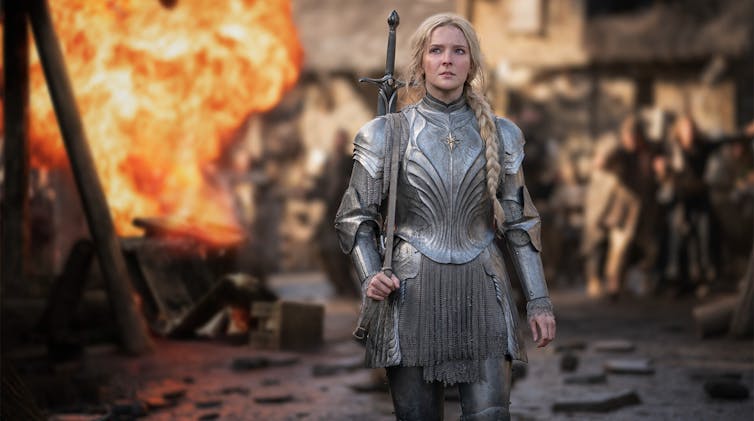Early reviews of Amazon Prime’s The Rings of Power have said that this “rich, gorgeous” eight-episode prequel to Lord of the Rings is “so astounding” it makes HBO’s rival fantasy series House of the Dragon “look amateur”.
Such soundbites had the world’s Tolkien fans – and no doubt Amazon bosses – salivating. According to the streaming giant’s own figures, 25 million viewers tuned into the Rings of Power on its first day.
Like many in this new production’s target audience, as a teenager I immersed myself in the world of Middle-earth, devouring Tolkien’s high fantasy novels. Later, I happily sat through repeat family viewings of Peter Jackson’s Lord of the Rings films and even his less gripping adaptation of The Hobbit.
As a professor of English literature, I have spent a lot of time promoting Tolkien’s masterpiece to my students, many of whom have become passionate devotees themselves. All of which to say, I had high hopes for Amazon’s new series.
But I’m going to call it. Despite its £50-million-an-episode price tag, The Rings of Power is an elvish armour-clad turkey.
It suffers from many ills. There is ponderous, often clunky dialogue. Tonally the series is all over the place and veers crazily between the insufferably pompous and (cue the harfoots, a type of hobbit) cloying. And it has some serious representation issues.
Aside from the writing, there are also a multitude of visual issues that, in an age of epic fantasy shows and films that can render entire landscapes of fire and brimstone and bring hulking dragons to life, are just not forgivable.
A confusing and troublesome narrative
Based on the appendices of The Lord of the Rings novels, the show tells the story of the creation of said rings, ostensibly pitting a variety of characters against the dark lord Sauron. But it’s hard to follow who we’re supposed to be rooting for.
Morfydd Clark’s ninja-like Galadriel acts in ways that are less than heroic at times. In episode one, for example, Galadriel eviscerates a snow troll whose only crime (other than not being an elf) is to have the temerity to defend his cave from the warriors who have invaded it. My sympathies were with the clumsy, inarticulate beast, as I’m sure many people’s were.

And, while the show’s colour-conscious casting is commendable, the decision to cast people of colour in key roles doesn’t inoculate the series against unthinking racism and cultural stereotyping in other respects.
Take the grating representation of the raggedy, dirty-faced Harfoots as, essentially, Irish travellers. This depiction, as has been pointed out, recalls the 19th-century anti-Irish cartoons of British caricaturist John Leech.
The Rings of Power also suffers from gauche classism. In his 1974 sonnet Them and [Uz], the poet Tony Harrison wryly recalls his snobbish English teacher clocking his working-class accent and declaring:
You’re one of those
Shakespeare gives the comic bits to
I found myself looking away whenever the harfoots – scruffy comedy kids from the local comprehensive to the elves’ oh-so-serious privately educated pupils – made an appearance. In places I felt embarrassed for the (excellent) actors, including Lenny Henry as the elder Sadoc Burrows and Markella Kavenagh as “Nori” Brandyfoot, who deserve better.
A visual headache
There’s also a problem with the show’s retina-popping “glorious visual effects”, which I found lurid, unpleasantly gaudy and cartoonish. They’re a bit like those images of the Carina Nebula from the James Webb Telescope, colourised in such a way that opaque or even invisible clumps of non-light-emitting dust are transformed into gossamer puffs of cosmic emerald and impossibly inky blues.
They’re breathtaking, but you can’t believe in them. In the same way Amazon’s hyper-colourised Middle-earth frustrates my efforts to suspend belief.
The Rings of Power also has a predilection for shooting faces (elves, dwarfs, harfoots, orcs alike) in ultra-close-up, distorting their features while casting them in unflattering shadows. Plus the backgrounds are so blurry that many scenes look like they were shot on an iPhone in cinematic mode, with everything simultaneously too close and too far away.
For me, incidentally, that last problem is even worse than Peter Jackson’s decision to shoot The Hobbit trilogy in 48 frames per second rather than the standard frame rate of 24 fps, which created a pin-sharp, motion-blur free experience that I wasn’t alone in finding alienating. https://www.youtube.com/embed/x8UAUAuKNcU?wmode=transparent&start=0
But the show’s unforgivable sin is that it’s boring. When anything vaguely exciting does happen, it’s over in seconds. On the other hand, if an expositional two-hander is required (and it often is), these energy-free zones drag on interminably. Things improve a little in the second episode, but by that point, Prime Video’s “forward 10s button” had begun to exert the pull of one of the eponymous rings of power themselves. I just about managed to resist clicking it.
There are a few satisfying Easter eggs. The scene where Nori’s father, Largo Brandyfoot, carries a live giant rabbit will be appreciated by fans who know their Tolkien deepcuts. In a cancelled footnote in an early draft of Lord of the Rings (see Appendix F), Tolkien remarks that the “faint suggestion” of rabbit in hobbit “appealed to me” (although elsewhere he rejected any connection between hobbits and their floppy-eared near homonyms).
I also liked the opening title sequence, where grains of rock form cymatic (and Lord of the Rings-significant) patterns on a membrane vibrating to The Rings of Power theme tune, reminding Tolkien afficionados that Middle-earth was supposed to have been sung into existence. That was neat.
Individual screen shots from The Rings of Power may be sumptuous, goregeous, awe-inspiring, even. But as a whole, the show is a mishmash of overly-staged, overly-stylised and frequently misfiring ideas. It simply doesn’t work.
Richard Marggraf-Turley, Professor of English Literature, Aberystwyth University
This article is republished from The Conversation under a Creative Commons license. Read the original article.




